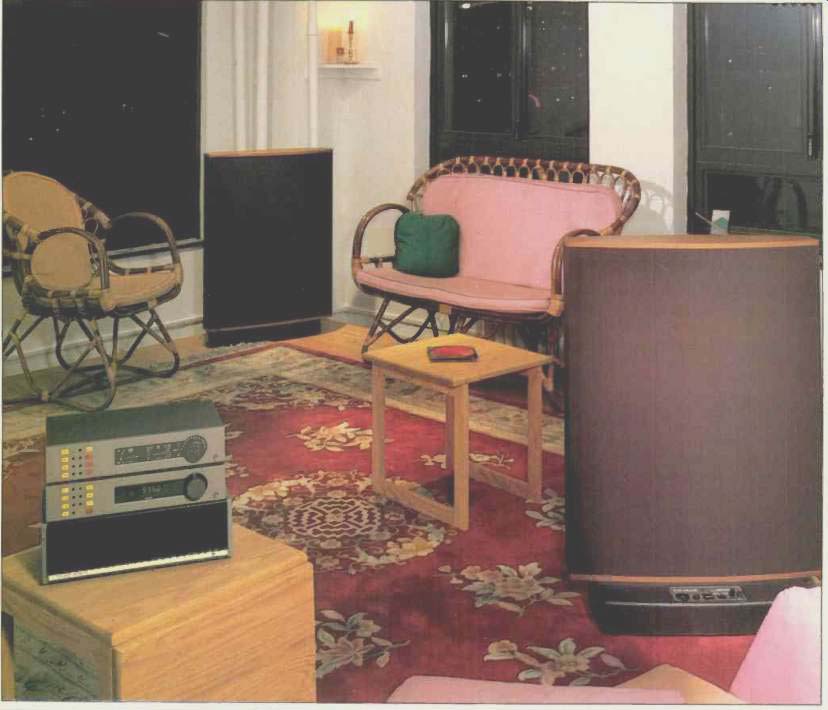
No, this is not a "rich man's one brand system"! It's just that the Editor and I found out that anyone who purchased the Quad 34 control unit and the 405 amplifier would probably purchase their matching FM4 tuner. Quad styling is so different from the usual, anodized-aluminum front panel design approach that trying to mate such components with other Quad units simply wouldn't look right. I also discovered audio enthusiasts either love the Quad component styling or they hate it; there seems to be no in between. Finally, I found that' Quad electrostatic speaker enthusiasts (whose numbers have grown substantially since the introduction of the ESL 63) are more apt to choose Quad components to power them than are people who favor more conventional dynamic speaker system designs. All this is by way of explanation as to why we chose to report on four Quad components in one review; five, if you count the loudspeakers as two components.
Tuner Layout
The buff-colored front panel of this FM4 tuner is most unusual in appearance as well as in the layout of its control functions. Tuned-to frequencies are digitally displayed (though the electronic tuning is not frequency synthesized), and continuous tuning is accomplished by means of a large knob at the right of the front panel. Nearby is a power on/off button, while to the left of the display area are eight pushbuttons, identified as 1 through 7 and "Tune," plus eight LED indicator lamps. The buttons and lights are used to preset and call up any of seven of your favorite stations, once they have been stored in the tuner's memory circuits. The display area indicates not only frequencies of received signals but signal strength and correct center channel tuning. Both of these useful bits of information are supplied by a double bar-graph. Its height denotes signal strength, while equal height of both bars denotes correct center channel tuning. Grasping the tuning knob causes interstation muting and a.f.c. to be switched out, but they are activated when you let go of the knob. Stereo transmissions light up an indicator just to the right of the frequency numerals in the display area.
The tuner's antenna input uses a coaxial connector that's apparently standard in Britain, but not here. The correct connector is supplied with the tuner, but you must solder it to your transmission line. The British, apparently, expect this sort of extra work when they buy an upscale audio product; in fact, I suspect that they rather enjoy doing this bit of home assembly, for I find that many British (and, for that matter, European) audio products require one to assemble or solder before they can be used. Happily, that was the only thing on the FM4 requiring extra assembly work. Quad did supply an adaptor cable for converting the confounded DIN plug to our more usual phono tip plugs. A prewired a.c. line cord suitable for the U.S. was also supplied, as were interconnecting a.c. cords which enable you to hook up all three of the audio components so that the control unit, Model 34, turns them all on from its front panel.
================
MANUFACTURER'S SPECIFICATIONS
FM4 Tuner
30-dB Quieting Sensitivity, Mono: 1.0 µV (11.2 dBf), 75 ohms.
50-dB Quieting Sensitivity, Mono: 2.7 µV (19.84 dBf), 75 ohms.
S/N: Mono, 76 dB; stereo, 70 dB. THD, 1 kHz: Mono, 0.15%; stereo, 0.15%.
Selectivity: 53 dB.
Capture Ratio: 1.5 dB.
Frequency Response: 20 Hz to 15 kHz, +0,-1.0 dB.
Crosstalk (Separation), 1 kHz: 40 dB.
Dimensions: 12.64 in. (32.1 cm) W x 2.52 cm (6.4 cm) H x 8.15 cm (20.7 cm) D.
Weight: 6.6 lbs. (3 kg).
Price: $625.00.
34 Preamplifier/Control Unit
Rated Output (Main/Tape): 0.5 V/100 mV.
Input Sensitivity: MM phono, 3 mV; MC phono, 0.3 mV; radio and AUX, 100 mV; tape playback, 300 mV. Maximum Input: MM phono, 150 mV; MC phono, 15 mV; radio and AUX, 5 V; tape playback, 15 V. S/N, A-Weighted: MM phono, 75 dB; MC phono, 70 dB; radio and AUX, 88 dB; tape playback, 87 dB; minimum volume (residual), 105 dB. THD: 0.05%, 30 Hz to 10 kHz, worst case.
Frequency Response: High level, 30 Hz to 20 kHz, ±0.3 dB; phono, RIAA ±0.5 dB.
Dimensions: 12.6 in. (32.1 cm) W x 2.5 in. (6.4 cm) H x 8.2 in. (20.7 cm) D.
Weight: 7 lbs. (3.2 kg).
Price: $625.00.
405 Amplifier
Power Output: 100 watts per channel, 8-ohm loads, 100 Hz to 10 kHz.
Rated THD: 0.01% (0.05% at 10 kHz).
Input Sensitivity for Rated Output: 0.5 V rms.
Frequency Response: -1 dB at 20 Hz, -0.5 dB at 20 kHz, and -3 dB at 50 kHz.
Crosstalk: 80 dB at 100 Hz, 70 dB at 1 kHz, and 60 dB at 10 kHz.
S/N: 95 dB, A-weighted; 90 dB, unweighted.
Dimensions: 13.4 in. (34.05 cm) W x 4.5 in. (11.5 cm) H x 7.7 in. (19.5 cm) D.
Weight: 20 lbs. (9 kg).
Price: $675.00.
ESL-63 Electrostatic Speakers
Nominal Impedance: 8 ohms.
Sensitivity: 86 dB SPL, at 1 meter, on axis, for 2.83-V rms input.
Dimensions: 26 in. (66 cm) W x 36.4 in. (92.5 cm) H x 10.63 in. (27 cm) D, including 5.9-in. base.
Weight: 41.1 lbs. (18.7 kg)
Price: $3,310.00 per pair.
Total System Price: $5,235.00.
Company Address:
425 Sherman Ave., Palo Alto, Cal. 94306.
=================
Control Unit Layout
This preamplifier/control unit looks, for all the world, just like the tuner. Its volume control replaces the tuning knob. The power on/off button is located in the same spot as on the tuner. In place of the display area is an opening in the front panel which houses a "Bass Lift" control and a "Tilt" control, two unique tone compensation controls developed by Quad. The eight buttons at the left of the panel (along with appropriate LED indicators) now serve as program selection switches ("Radio," "Disc," "AUX," "Tape") and mono/stereo, high-cut filter, and slope selection switches. A balance control in the form of a lever is mounted concentrically with the Model 34's main volume control.

Fig. 1--Simplified schematic of Quad 405 amplifier, showing Class-A, current
dumpers, and bridge components.
I encountered no kit-building requirements when I installed this component, and all necessary DIN-to-pin plug adaptor cables were supplied, as well as another a.c. patch cord. Phono inputs were already of the phono-jack type and were, in fact, part of a subassembly which is easily removed by loosening two screws, thereby permitting the user to substitute phono equalizer/preamplifier modules for moving magnet or moving-coil cartridge inputs. Quad has a variety of these available, each with a predetermined gain factor and a specified input impedance. The two modules supplied as standard equipment with the Model 34 handle moving-magnet cartridges rated at 3-mV input sensitivity and requiring 47-kilohm/220-pF loads and, for moving-coil pickups, a module having an input sensitivity of 100 µV and presenting a load of 100 ohms and 22 nF. When substituting one preamplifier module for another, a flat multi-conductor cable connected to the preamp module in use has enough slack so that disconnection and reconnection of the new module can be comfortably made without having to open it up and get inside the chassis.
Power Amplifier Layout
The last electronic audio component of this group, the 405 amplifier, has no controls and can therefore be installed out of sight or in close proximity to the control unit and the tuner. Spring-loaded speaker terminals are used for connection of speaker cables. The amplifier may be limited to an output of 20 V rms (that would work out to 50 watts across a true 8-ohm resistive load) by inserting supplied shorting links in each amplifier p.c. board module. This precaution should be taken if the speakers used with the Model 405 are incapable of handling a full 100 watts of power. Specific note is made in the amplifier owner's manual that this limiting feature is not required if the amplifier is going to be used with Quad ESL 63s, the speakers I ultimately used in the listening tests.
Like most electrostatic loudspeaker systems, the ESL-63s require a polarizing voltage, and that means connections by means of a line cord to an a.c. outlet, in addition to the usual signal connections made via color-coded loudspeaker terminals. The speaker systems incorporate protection circuitry which either compresses overly large input signals (over 40 V rms) or shorts out the signal input from the driving amplifier. Amplifiers which are not short-circuit protected should therefore not be used with the ESL-63 speakers.
Circuit Highlights
The Quad 405 has been termed a "current dumping" amplifier by its designers. In such an amplifier there is, in effect, a low-powered, ultra-high-quality amplifier plus a high-powered, heavy-duty amplifier (Fig. 1). The low powered amplifier controls the loudspeakers at all times, calling upon the high-powered section only when high-powered peaks to the speaker load are called for. The small amplifier is operated so that, provided the larger power transistors (the "dumpers") get within range of the required output current, it will fill in the remainder of the signal waveform accurately and completely.
Reproduced sound quality is therefore solely dependent upon the smaller, more accurate amplifier. In this arrangement there are no internal adjustments, nor is alignment required, and the choice of power transistor types is less critical.
The most unusual circuits found in the Quad 34 control unit are the "Bass Lift" and "Tilt" circuits, which replace the more common bass and treble boost and cut circuits found on most amplifiers and receivers. When the "Bass Lift" control is operated in any of its lift settings, it acts as a smooth progressive booster for use with small loudspeakers having limited bass response. In its "Step" mode, the control acts as a step filter, producing a 5-dB drop at either 100, 170, or 300 Hz. This characteristic, according to Quad, is especially useful in minimizing the effects of standing waves in a room, particularly when speakers have to be positioned in corners.
The FM4 tuner owner's manual tells us little about its circuitry. I have discussed the design philosophy of this relatively lackluster component with executives of the company. According to them, its design is essentially an attempt to make the component easy to use, have it deliver sound quality that is at least as good as what is likely to be transmitted over FM stations, and, in general, to keep it as simple as possible. More about whether or not these goals were met later on.
Measurements
After connecting an antenna transmission line in order to access the 75 ohm input (there's no provision for 300 ohm twin lead connections), I was surprised to find errors in Quad's listed specifications for sensitivity. I have corrected them in our "Manufacturer's Specifications" section (see sidebar); however, 2.7 µV across 75 ohms is not 8 dBf, as Quad claims, but 19.84 dBf, and 25 µV across 75 ohms is not 28 dBf, as claimed, but 39.17 dBf. Given the corrected figures, the FM4 actually did better than claimed. The result for 50-dB quieting in mono was 17 dBf (2.0 uV), while in stereo it measured 38.45 dBf. Usable mono sensitivity was 1.1 µV across 75 ohms or 12.04 dBf; in stereo, the 3% noise-plus-THD point (usable sensitivity) was reached with a signal input of 2.0 µV or 17 dBf. Signal-to-noise ratio measured 76 dB in mono, as claimed, and was 3 dB better than claimed in stereo, or 73 dB. Mono THD for a mid-frequency modulating signal was 0.15%, and 0.11% in stereo. Plots of noise and distortion, in mono and stereo, versus signal strength are shown in Fig. 2, and a plot of distortion versus modulating frequency is shown in Fig. 3. Selectivity measured just over 60 dB, while capture ratio was 1.5, exactly as specified. AM suppression fell 2 dB short of the 60 dB claimed, although image rejection, which measured 85 dB, exceeded claims by 5 dB. The i.f. rejection was 95 dB.
When I began to plot frequency response, I got a surprise. In order to speed this review, Quad originally air shipped equipment direct from England to Audio-including a tuner that was factory set for 50-µS de-emphasis, rather than the U.S. standard of 75 µS. Since the U.S. importer stocks tuners with the right de-emphasis, I obtained a second sample, whose frequency response yielded the upper curve shown in Fig. 4.
Separation versus frequency is also depicted in Fig. 4. In the unit tested, separation was unbalanced. When the left channel was modulated, crosstalk into the right channel was down 45 dB at 1 kHz, 47 dB at 100 Hz, and 27 dB at 10 kHz. With the right channel modulated, crosstalk into the left channel measured 40 dB at 1 kHz, 38 dB at 100 Hz, and 27 dB at 10 kHz. Figure 5 displays crosstalk and distortion products appearing at the output of the unmodulated channel when a 5-kHz, 100% modulating signal is applied to the opposite channel. Here the sweep is linear, from 0 Hz to 50 kHz, the tall spike at the left is the desired 5-kHz output signal, and all other observed components are undesired outputs from the opposite channel, including a small amount of 38-kHz subcarrier component signal appearing just to the right of the center of the display. Vertical sensitivity in this photo is 10 dB per division.
Based on my measurements, the most outstanding component in this group is without a doubt the Model 34 preamplifier/control unit. I tested it using both the MM and MC phono modules, and RIAA equalization was very nearly perfect for each. In fact, for the MM module, I detected no deviation from 30 Hz to 20 kHz. The MC unit had a minor amount of roll-off (around 0.5 dB) at 15 kHz. My sensitivity and S/N measurements were conducted in accordance with IHF standards, and are therefore not easy to correlate with the figures quoted by Quad. But however you measure S/N on this preamp, the results will be excellent in terms of audibly perceived hum and/or noise.
Phono S/N measured 87 dB below 5 mV input for 0.5-V output with the MM module, and 84 dB with the MC module. High-level S/N measured 92 dB with reference to 0.5-V in and out.
High-level frequency response was flat to within 0.1 dB from 20 Hz to 20 kHz.
Worst-case THD measured 0.01% for a 1-kHz test signal, 0.02% for a 20-Hz signal, and 0.05% for a 10-kHz signal.
The SMPTE IM measured 0.03%. Input sensitivity was 3.4 mV for the MM phono module, 120 µV for the MC module, 100 mV via the high-level "Radio" or "AUX" inputs, and 300 mV for the "Tape Play" inputs.
-------------
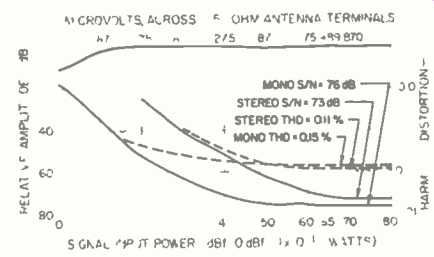
Fig. 2--Mono and stereo quieting and distortion characteristics, FM section,
FM4 tuner.
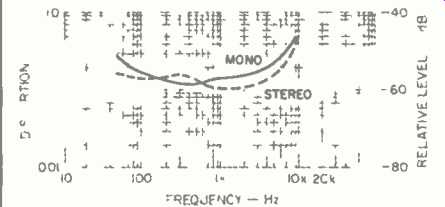
Fig. 3--THD vs. modulating frequency, Quad FM4 tuner.
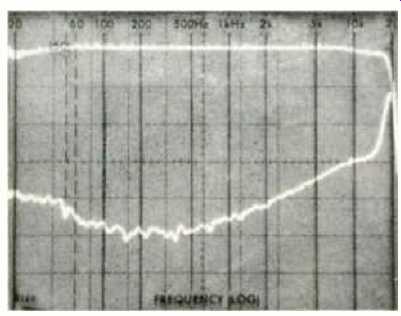
Fig. 4--Frequency response, FM4 tuner (upper trace) and separation vs. frequency.
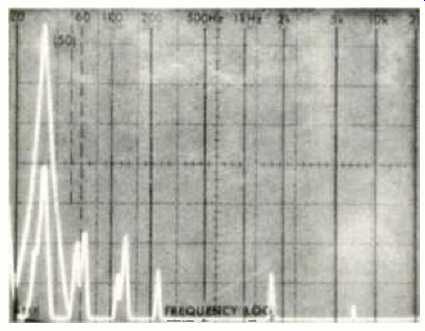
Fig. 5--Crosstalk and distortion products at the unmodulated channel's output,
with a 5-kHz, 100% modulating signal applied to the opposite channel of the
FM4. Sweep is linear from 0 Hz to 50 kHz.
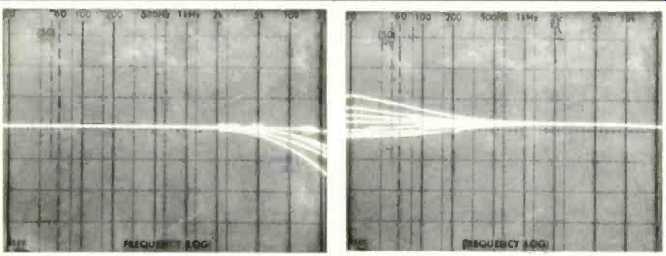
Fig. 6--Frequency response characteristics of the various high-cut filter
settings on the Quad 34 control unit. Sweep is logarithmic, from 20 Hz to
20 kHz, and vertical sensitivity is 10 dB/octave.
Fig. 7--"Lift" and "Step" response characteristics of the bass control, Quad 34. Frequency sweep is logarithmic, from 20 Hz to 20 kHz, and vertical sensitivity is 10 dB/ octave.
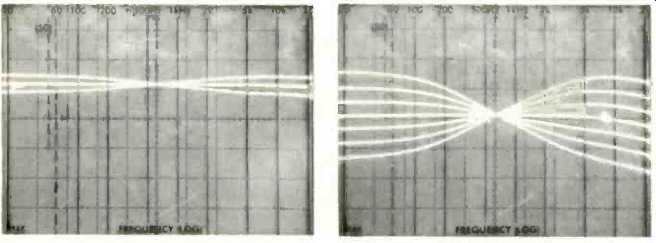
Fig. 8--"Tilt" control setting of Quad 34 alters bass and treble
response simultaneously. Logarithmic frequency sweep, 20 Hz to 20 kHz, and
10 dB/ octave vertical sensitivity.
Fig. 9--Expanded view of "Tilt" control action of Quad 34. Logarithmic frequency sweep, 20 Hz to 20 kHz, but 2 dB/octave vertical sensitivity.
---------------
Figures 6, 7, and 8 all depict logarithmic frequency sweeps, from 20 Hz to 20 kHz, in which vertical sensitivity is 10 dB per octave. Figure 6 shows the response of Model 34 for the various settings of the high-cut filter switch.
Figure 7 shows multiple plots of response for the various settings of "Lift" and "Step." Figure 8 shows plots of the unique "Tilt" control, which affects both bass and treble frequencies. Depending upon the setting, the "Tilt" control boosts bass while cutting treble (in minute selectable steps) or cuts bass while boosting treble. Despite the relatively small amount of compensation provided by this control, its audible effect is quite discernible, and it could be quite effective in compensating for deficient room acoustics and even for deficiencies inherent in many speaker systems. To present a clearer picture of just how the "Tilt" control works, I expanded the sensitivity of the spectrum analyzer display to 2 dB per division in the photo of Fig. 9 and plotted a separate response curve for each of the control's settings.
The power output rating of the 405 power amplifier is not given in accordance with FTC requirements. Though nominally rated at 100 watts per channel, continuous power, different distortion ratings are given for different frequencies. And, since the highest frequency for which THD is quoted is 10 kHz, if I had to translate this into a standard power rating, I'd have to call it "100 watts continuous power per channel, 8-ohm loads, from 100 Hz to 10 kHz, with no more than 0.05% THD." In fact, the amplifier does better than that at the low end, but it does not produce 100 watts at 10 kHz for that quoted lower level of harmonic distortion. At mid-frequencies, the 405 can deliver more than 110 watts for the quoted 0.05% THD. At its nominal 100 watt output level, for a 1-kHz test signal, THD measured only 0.007% while SMPTE IM measured 0.008%. Damping factor was greater than 100. CCIF IM was 0.0088%, and IHF IM (twin-tone measurement) was less than 0.03%the lowest level that I can resolve on my spectrum analyzer. Signal-to-noise ratio measured 84 dB below 1 watt out, for 0.5 V in, unweighted. Using an A weighting network, S/N increased to 101 dB.
System Evaluation and Listening Tests
Let me state at the outset that I made no attempt to perform any lab measurements on the ESL-63 loudspeaker systems which formed part of this total component package from Quad; I used them simply to listen to the other components. (I'm told that my good friend and colleague Dick Heyser will be doing his usual thorough job of measuring these highly respected electrostatic systems in a future issue.) Nevertheless, like any true audiophile, I feel I have the right to offer a subjective opinion concerning these bigger, younger relatives of the earlier ESL speakers (which, incidentally, are still in Quad's line). To my ears, the ESL-63s are a big improvement over the earlier ESLs.
Their overall tonal balance is better, though I find that bass response is still not what I would like it to be. Here's a case where the "Tilt" control on the Model 34 can really help-at least in my listening room and for my ears. In terms of power needs, the 405 amplifier seemed ideally suited to the speakers, with enough power to deliver good, realistic sound levels, but not enough to damage the systems or to activate the protection circuitry. The fact that the 405 amp is unconditionally stable (and it is-I confirmed this with capacitive, open-circuit, and short-circuit loads) is a boon, too, when driving electrostatic speakers. Speaker placement was found to be extremely important with the ESL-63s, as indeed it would be with any dipole speaker system. I found that the speakers wanted to be further apart than I would have suspected, but stereo imaging was excellent. The "Tilt" control also served to reduce the somewhat overly brilliant treble response which, to my ears, has always been characteristic of earlier Quad ESLs and continues to exist in the ESL-63s.
As I said above, if I had to rank the order of the other three components in terms of performance, ergonomics and general merit, I would place the Model 34 control/preamp at the top of the list.
It's phono preamp modules represent an ideal solution to a matching problem that is always with us, and its controls operate in a way that is meaningful to music listeners, rather than just to technicians and engineers.
The amplifier is certainly a close runner-up in my personal ranking. It responded well to all of the difficult source material to which it was subjected during my many days of listening. The 405 not only drove the ESL 63s very well, it also supplied clean, undistorted power to my reference loudspeaker systems and to some less costly speaker systems that were passing through the lab during the period of testing.
That puts the FM4 tuner at the bottom of the list. I'm afraid the situation with FM in Great Britain (and in the rest of Europe) is very much unlike the complex FM picture we have in this country. There are fewer stations, and long-distance reception is not usually a problem thanks to "network" and relay arrangements which exist in many European countries. To be sure, under many (if not most) listening conditions in the U.S., and given the present quality of FM broadcasting, the FM4 is probably good enough. However, in my listening area at least, there are a number of really fine signals available.
So I think I would pass on the FM4 and choose another fine tuner, even if that meant breaking up the matching cosmetics of this distinctively European component group.
-Leonard Feldman
(Source: Audio magazine, Dec. 1983 )
Also see: Quad (Acoustical Mfg. Co., Ltd.) Model 405 Power Amplifier (Apr. 1979)
The QUAD Manchester Competitions (Apr. 1989)
= = = =